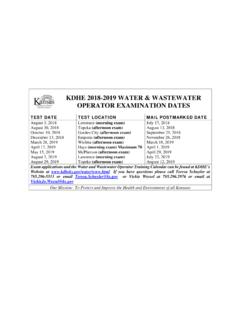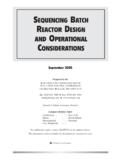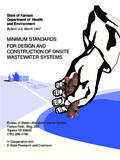Transcription of TABLES FIGURES - KDHE
1 IntroductionV-1 Tank Materials and ShapesV-2 Compartmented TanksV-4 Septic Tank effluent FiltersV-6 Septic Tank Location V-7 Operation of Septic SystemsV-8 Septic Tank Management and MaintenanceV-10 Septic Tank SafetyV-15 Septic Tank Design StandardsV-15 General RequirementsV-15 Special Considerations for Concrete TanksV-17 Special Considerations for Fiberglass and Plastic TanksV-18 Septic Tank Placement SpecificationsV-18 References and Additional ReadingV-20 TABLESV-1 Minimum septic tank capacities based on the number of household bedrooms V-1V-2 Inert or Slow to Decompose Items that Should Not Go into a Septic TankV-10V-3 Common Household Hazardous WasteV-11 FIGURESV-1 A Two Compartment Septic TankV-2V-2 Example of Polyethylene Plastic TankV-4V-3 Two Septic Tanks In SeriesV-5V-4 Septic Tank effluent FiltersV-6V-5 Measuring Sludge and Scum in a Septic TankV-1312/02 SEPTIC TANKS V-1 INTRODUCTIONThe solids in raw household wastewater will quickly clog all but the most porous gravelformations.
2 To enhance soil absorption, raw wastewater is discharged to a septic tank wheresolids are retained. A septic tank is a watertight chamber that:!separates the settleable and floatable solids, !promotes the growth of anaerobic bacteria necessary to decompose the solids, and!provides storage for the resulting sludge and septic tank reduces the velocity of wastewater and permits the settling of materialsheavier than the liquid. Concurrently, scum, grease and other materials lighter than the waterfloat to the top. A vertical section of a properly operating tank would show it divided into threedistinct layers; scum at the top, a middle zone of generally clear water relatively free of solidscalled the clear space , and a bottom layer of tanks are designed to handle all the normal daily flow a household or businessproduces and should have sufficient capacity for a minimum detention of at least 2-3 times thedaily wastewater flow.
3 For this reason, design should be based upon the maximum capacity of ahome rather than its number of inhabitants at any particular time. Minimum capacities for septictanks are shown in table V-1. The design should allow for the inclusion of laundry and garbagegrinder wastes. It is desirable to install larger tanks whenever possible. Tanks larger than the minimumhave the advantage of more solids separation into the scum and sludge layers, and more solidsstorage. The larger capacity provides less carryover of solids, resulting in prolonged life of thesoil absorption unit. Larger tanks also require less frequent cleaning and allow for futureexpansion of the home, which provides a positive cost-benefit return. Design flow capacity doesnot allow for roof drainage, other surface water, footing drainage, sump pump, or any othersubsurface drainage, so these must be excluded from the V-1.
4 Minimum Septic Tank Capacities Based on the Number of Household Tank Capacity (gallons)2 Number of Bedrooms1 MinimumRecommended3 1,0003 1,3504 1,200 1,8005 1,500 2,250 1 For each additional bedroom add 150 gallons to the recommended held by the tank below the liquid level (invert of the outlet pipe).3 Minimum tank size is 1,000 TANKS V-2 Septic tanks are constructed with baffles or sanitary tees on both the inlet and outletpipes. Baffles or tees retain floating scum and minimize the disturbance of the settled sludge orfloating scum as wastewater enters and leaves the tank. Septic tank design should includeprovisions for two openings through the top that are large enough for clean out and repair. Theseshould be located to permit easy access to the tank inlet and outlet devices.
5 It is important thatthe openings themselves are accessible and have covers that exclude water. Section viewsshowing details for a concrete septic tank are in Figure MATERIALS AND SHAPEST hree types of materials have proven to be acceptable for long-term use of a tank:concrete, polyethylene plastic, and fiberglass. Although tanks have been made from metal, thecorrosive atmosphere and contents cause rapid disintegration. The metal is soon compromised,leaving nothing but a rust-lined underground void, subject to collapse and obviously leaking. Simply stated, metal tanks should never be allowed in a wastewater treatment V-1. A Two Compartment Septic Tank: a. Top View, b. Side Section View12/02 SEPTIC TANKS V-3 Box-like concrete septic tanks are the most common.
6 Properly reinforced and mixed,concrete forms a pre-cast tank that is strong, durable, stable, and modest in cost. The metalreinforcement used in the sidewalls must be positioned in the form so that the metal is alwayscovered by at least an inch of concrete. If the rebar or wire mesh is exposed, not only is theconcrete strength compromised, but the metal deterioration (as discussed previously) furtherweakens the tank. Any exposed reinforcement is a valid reason to reject that the septic tanks are very heavy, requiring special trucks for transport andplacement. If struck or dropped, the concrete may crack. A cracked tank will leak and must berejected. The tank forms should be filled with a single pour. If the form is partially filled andthe concrete hardens before the rest of the fill, a cold joint is created.
7 Cold joints are prone toseeping or leaking and are not acceptable in septic tanks. It is a good idea to fill a tank withwater and check for leaks before placement in the two-piece septic tank with a horizontal joint around the middle (also called a clamshell tank) is designed as two boxes that fit together, rim to rim. One box forms the bottom halfand the other box (with the inlet and outlet in opposite ends and the hatch or hatches in the top)is the top half. The bottom half is placed in the excavation, a rubber or asphalt sealer is fittedcompletely around the rim before the top half is lowered into place on the sealer. This designdivides the weight between the two halves, making it easier to handle and position. However,the potential for leakage is great along the seam where the two halves meet.
8 This tank can onlybe checked for leakage after it has been placed. Should leaks be detected, it is necessary topump out the water and reseal before testing again. Leakage has been a real disadvantage of thetwo-piece design, and its use has fallen out of and polyethylene plastic tanks are so similar that both are discussed here as plastic tanks . Plastic tanks are manufactured by molding and are usually round or capsule-shaped (horizontal cylinder). Because the entire tank is formed as a single piece, there are noseams to seal, and the material is resistant to impact damage. These tanks great advantage aswell as their disadvantage, is their light weight. The lightness allows these tanks to betransported in an ordinary pick-up. The tank can be set in place with only a backhoe or hand-carried by a few people.
9 These tanks are life-savers in situations where a heavy truck cannotgain access to place a concrete tank. Figure V-2 shows an example of a polyethylene plasticseptic to their lightness, plastic tanks must be installed according to the manufacturer sinstructions. This usually involves setting the tank on a carefully leveled and compacted sand orsmall gravel bed in the bottom of the excavation. Sand or fill is tamped around the tank as it isfilled with water. Failure to observe the procedures stipulated by the manufacture can result in atilted or deformed tank, or one that literally floats out of the ground. Plastic tanks are deeplyribbed for reinforcement and for a better grip by the soil. Although plastic tanks are readilyavailable for many uses, only those specifically designed for use as septic tanks can be used forthis TANKS V-4 Figure V-2.
10 Example of Polyethylene Plastic TankCOMPARTMENTED TANKSA lthough a single compartment tank can give acceptable performance, research dataindicates that multiple compartment tanks perform better because they provide greater protectionagainst solids carryover into the discharge pipe. Multiple compartment tanks have beenrecommended because of improved effluent quality. Adding a high quality effluent filter to asingle compartment tank may provide equal or higher quality effluent than a 2 compartment tankwith no effluent term compartmented as used here, refers to chambers within a tank or tanks placedin series. A number of arrangements are possible. Figure V-1 illustrates a single tank with a12/02 SEPTIC TANKS V-5watertight partition separating the individual compartments.
















